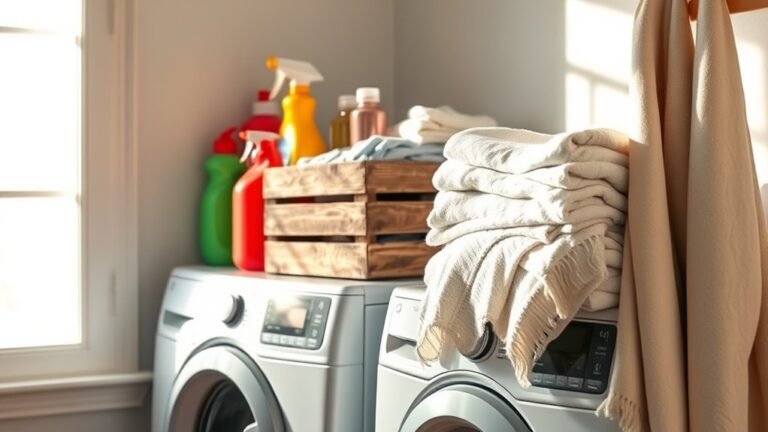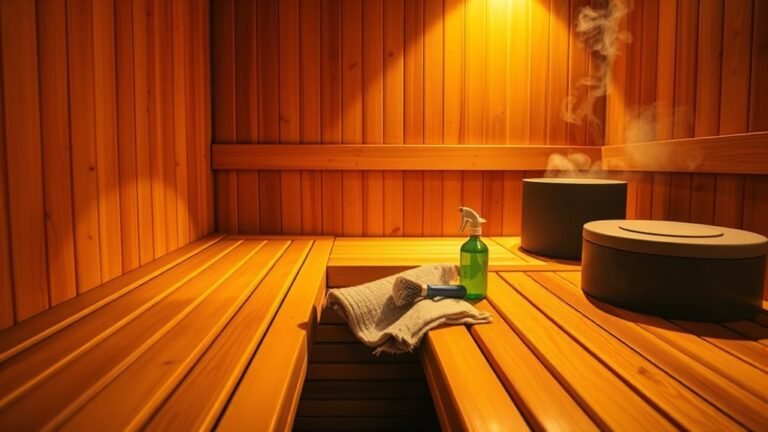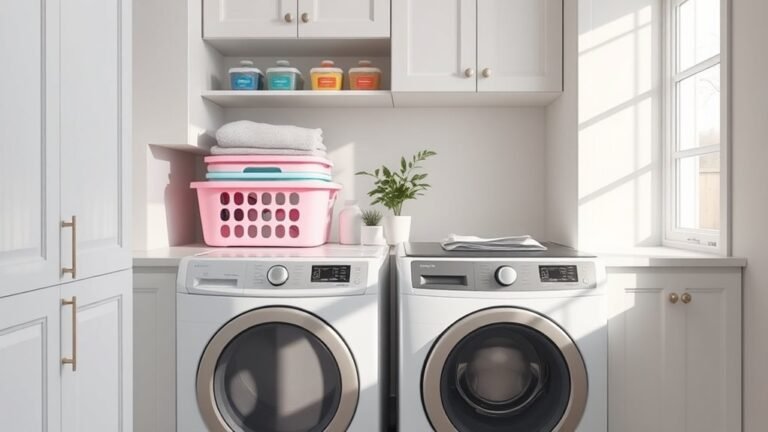Cleaning With Toys: What Works and What Doesn’T
You can make cleanup fun by using toys that encourage sorting, rewarding, or organizing, turning chores into playful challenges that promote independence and teamwork. Avoid flashy or complex toys that distract from the task. Simple games like timed tidy-ups or color-coded sorting keep kids engaged without pressure. Assigning age-appropriate tasks and ensuring safety helps maintain a positive experience. If you want to discover creative strategies and know when it’s best to pause using toys during cleaning, there’s more helpful advice ahead.
Benefits of Using Toys to Encourage Cleaning
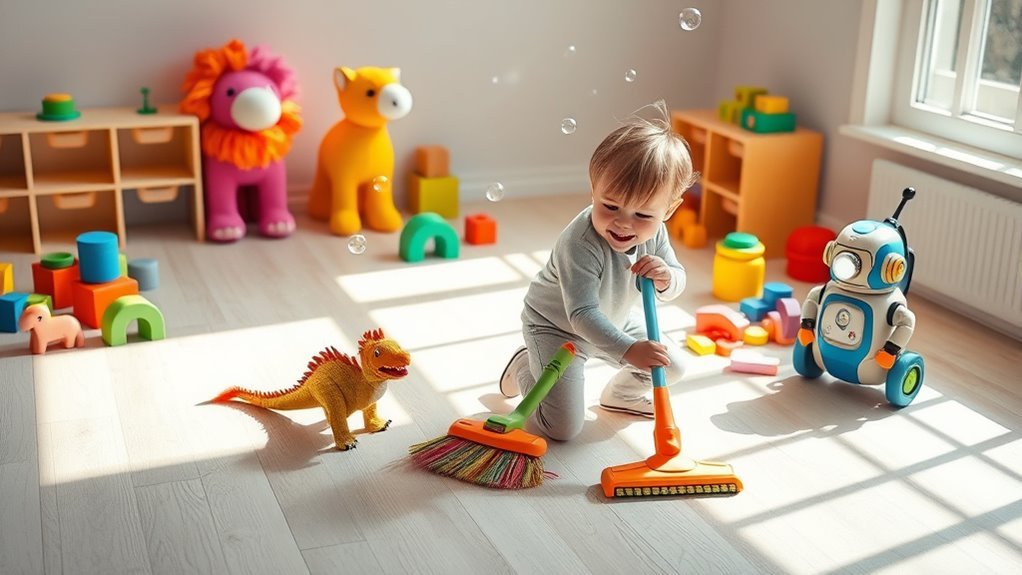
Although cleaning might feel like a chore, using toys can turn it into a fun and engaging activity for you and your child. Toy incentives provide a playful twist on tidying up, making the task less intimidating and more appealing. When you introduce cleaning rewards, you not only motivate your child but also foster a sense of accomplishment and independence. This approach encourages positive habits without pressure, promoting a developmental environment where your child learns responsibility naturally. By integrating toy incentives, you create moments of joy and cooperation, transforming cleanup into quality bonding time. Embracing this method helps you both enjoy freedom from frustration and resistance, making cleaning a smoother, more rewarding experience for your family.
Types of Toys That Motivate Cleanup
Three types of toys stand out as effective motivators for encouraging cleanup: interactive toys, reward-based toys, and organizational playsets. Interactive toys engage kids directly, making the cleanup process feel like play rather than a chore. When you use toy incentives like these, children often feel more in control and willing to participate. Reward-based toys provide tangible cleanup rewards, offering a clear benefit for tidying up, which encourages consistent habits. Organizational playsets combine function and fun, turning storage into an enjoyable activity. By choosing these types, you’re not just pushing kids to clean—you’re fostering independence and responsibility in a way that respects their need for freedom. This approach helps make cleanup a positive, motivating experience rather than a forced task.
Toys That Can Distract From Cleaning Tasks
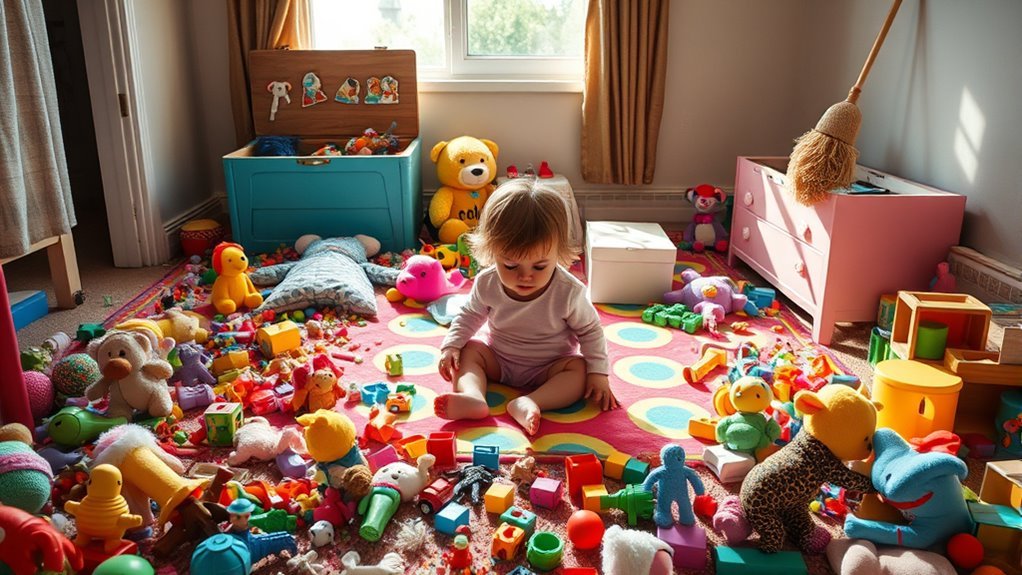
When cleaning with toys, it’s easy to get sidetracked by ones that interrupt your focus and turn cleanup into playtime. You might find yourself spending more time managing distractions than actually tidying up. Recognizing which toys encourage productivity versus those that disrupt it can help you keep tasks on track.
Toys That Interrupt Focus
While toys are essential for play and learning, some can easily pull your attention away from cleaning tasks. Toys with flashing lights, loud sounds, or complex interactive features act as strong distraction factors, making it tough to maintain your focus. When you’re trying to tidy up, these toys interrupt your concentration and slow progress. To stay on track, it helps to use focus techniques like setting clear time limits for play or designating specific areas for toys. You might also find it useful to rotate toys, keeping only a few accessible during cleaning time to minimize temptation. By understanding which toys disrupt your flow, you can create an environment that supports both play and productivity, allowing you the freedom to clean efficiently without constant interruptions.
Playtime Versus Productivity
Recognizing which toys pull your attention away is just the beginning of balancing playtime with productivity. When you’re cleaning, it’s easy to get sidetracked by toys that demand constant interaction, breaking your flow. To maintain a healthy playtime balance, try setting specific moments for play separate from your cleaning tasks. Productivity tips like using timers or designating “toy-free” zones can help you stay focused. Remember, it’s not about eliminating fun but managing distractions so you can enjoy both cleaning and play without stress. By understanding how certain toys impact your concentration, you gain control over your environment, creating a space where freedom and efficiency coexist. This approach empowers you to clean effectively while keeping joy alive.
Creative Games to Make Tidying Up Fun
Since tidying up can often feel like a chore, turning the process into a creative game can make it much more enjoyable for everyone involved. You can use cleaning challenges and playful incentives to spark motivation and make the task feel less like work. By setting simple goals and rewarding progress, you encourage a sense of freedom and accomplishment.
| Game Idea | Playful Incentive |
|---|---|
| Toy Sorting Race | Small prizes for winners |
| Color-Coded Cleanup | Stickers for each color |
| Puzzle Piece Hunt | Extra playtime rewards |
| Timed Tidy-Up | Choose the next game |
These games keep the atmosphere light and engaging, helping you overcome cleaning challenges with a sense of fun rather than obligation.
Practical Tips for Involving Kids in Cleaning
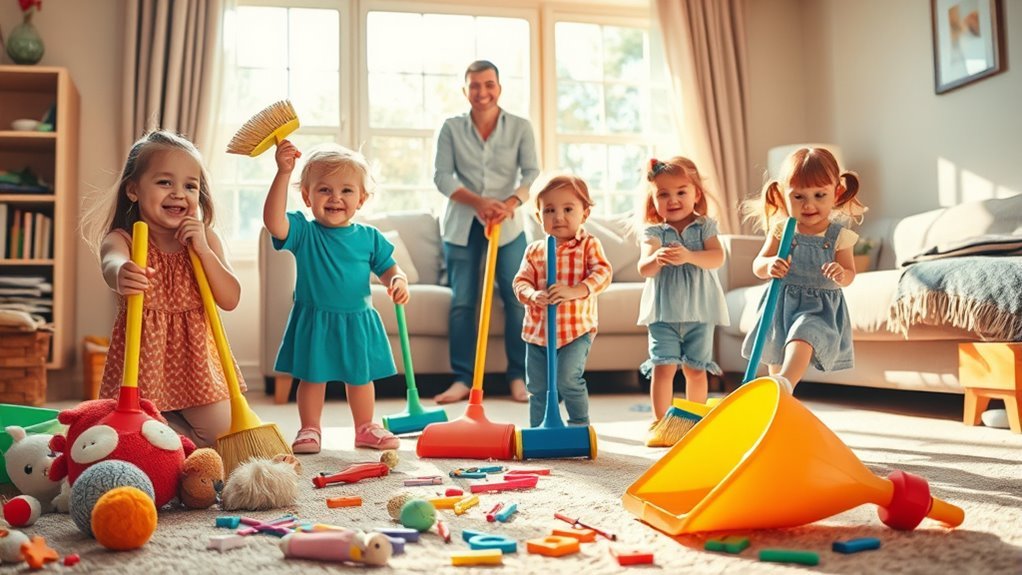
You can make cleaning a positive experience by assigning age-appropriate tasks that match your child’s abilities. Turning tidying up into a fun activity helps keep them engaged and motivated. Plus, using toy storage solutions makes organizing easier and encourages kids to take responsibility for their space.
Age-Appropriate Cleaning Tasks
Although involving kids in cleaning might seem challenging at first, assigning age-appropriate tasks can make the process smoother and more enjoyable for everyone. When you consider age suitability, you guarantee that each child feels confident and capable, which encourages independence rather than frustration. For toddlers, simple jobs like putting toys back in bins work well. Older kids can handle more complex chores like dusting or organizing shelves. Effective task division means matching chores to your child’s developmental stage while balancing fairness. This way, cleaning becomes a shared responsibility, not a burden. By tailoring tasks thoughtfully, you empower your kids to contribute meaningfully without feeling overwhelmed, creating a positive, cooperative environment that respects their growing abilities and your family’s freedom.
Make Cleaning Fun
How can cleaning become an enjoyable activity rather than a chore for your kids? Start by turning it into a game, using playful incentives to spark their interest. You might set a timer and challenge them to pick up toys before it rings, celebrating their success with small cleaning rewards like stickers or extra playtime. Involving them this way not only makes the task less intimidating but also nurtures responsibility naturally. Keep the atmosphere light and positive, avoiding pressure, so they associate cleaning with fun and freedom instead of obligation. By integrating these simple strategies, you empower your kids to take pride in their space while enjoying the process, making cleaning an engaging, shared experience rather than a dreaded duty.
Use Toy Storage Solutions
Organized toy storage solutions can transform tidying up from a challenging task into a manageable, even enjoyable routine for kids. When you use storage bins and clear toy organization methods, you give children a sense of control and independence. Label bins by toy type or color to make cleanup intuitive, turning chaos into order. Here’s a simple way to balance fun and function:
| Storage Bins Type | Best For |
|---|---|
| Clear Plastic | Easy toy identification |
| Fabric Bins | Lightweight, flexible |
| Stackable Boxes | Maximizes space |
When to Avoid Using Toys During Cleanup
Even though toys can make cleanup more engaging, there are times when using them might actually slow down the process or cause distractions. If you notice the cleanup challenges escalating because your child gets sidetracked playing with the toys instead of putting them away, it’s a sign to pause. Toy distractions can turn a quick tidy-up into a prolonged activity, making it harder for both of you to feel accomplished. When your goal is efficiency, especially during busy days or before guests arrive, it’s better to skip the toys and encourage straightforward cleanup routines. Understanding when to avoid toys helps you maintain balance, ensuring cleanup stays productive without sacrificing your child’s enjoyment and freedom to explore later on.
Frequently Asked Questions
How Do I Choose Non-Toxic Toys for Cleaning Activities?
It’s no coincidence that you want safe, non-toxic toys for cleaning activities—your child’s well-being matters most. When choosing, prioritize toys that meet recognized safety standards and look for materials like BPA-free plastic, natural rubber, or untreated wood. Avoid anything with harmful chemicals or small parts. By focusing on these material types, you’re protecting your child while encouraging their freedom to explore and learn through play safely.
Can Cleaning With Toys Help Develop Motor Skills?
Absolutely, cleaning with toys can boost your child’s motor skills through playful cleaning activities. When they use small brushes or sponges, they develop hand-eye coordination and fine motor control while having fun. This playful cleaning approach encourages freedom to explore movements and builds confidence in everyday tasks. It’s a great way to combine learning with joy, making skill development feel natural rather than forced.
Are There Age-Appropriate Toys for Different Cleaning Tasks?
When it comes to cleaning tools, you know that one size doesn’t fit all. There are plenty of toy types designed to match different ages and tasks, letting you tailor the experience perfectly. Toddlers might enjoy simple dusters or pretend brooms, while older kids can handle toy vacuum cleaners or mop sets. Choosing age-appropriate toys keeps things safe and fun, so your little one learns and plays without feeling overwhelmed.
How Do I Store Toys Used for Cleaning?
When it comes to toy storage, keeping things simple helps maintain cleaning organization. You’ll want to choose clear bins or labeled baskets so you can quickly find and put away each toy. Make it a habit to store them near where you clean, giving you easy access while keeping clutter minimal. This way, you stay organized without feeling restricted, making cleanup feel less like a chore and more like a smooth part of your routine.
What Are Alternatives if My Child Dislikes Cleaning Toys?
Like finding the right key to open a door, discovering alternatives if your child dislikes cleaning toys means exploring creative incentives and fun routines. You might try turning cleaning into a game, offering rewards for teamwork, or using music to set an energetic pace. Let your child choose tasks they enjoy, fostering independence while keeping chores lighthearted. This way, cleaning feels less like a burden and more like a shared adventure.


